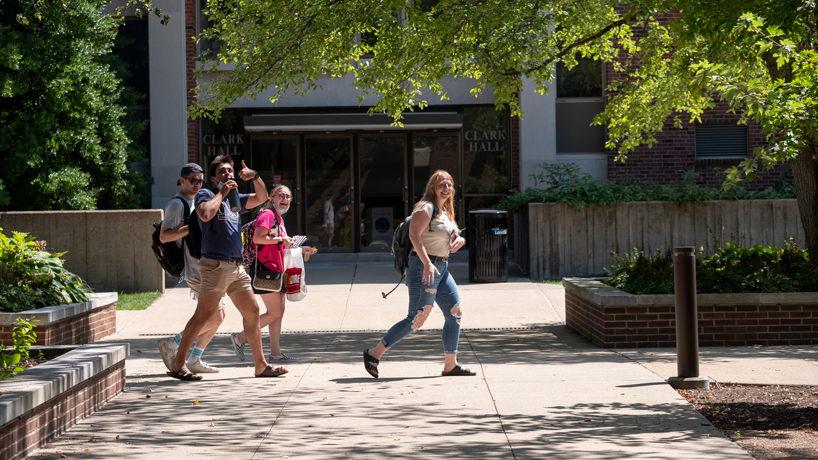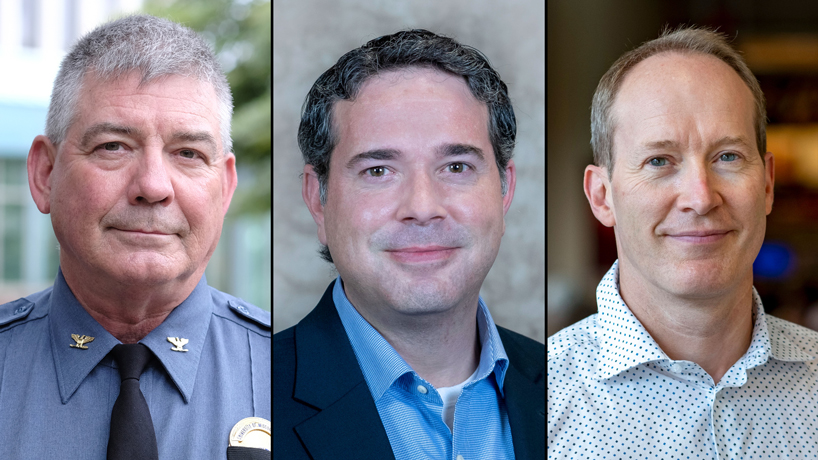
Members of Unified Command helped guide policy decisions throughout the COVID-19 pandemic so that students could return to campus and take classes safely while continuing to make progress toward their degrees. (Photo by August Jennewein)
The University of Missouri System moved last month to suspend UM System policy HR HR-702, which had set requirements and expectations for staff and faculty regarding COVID-19.
The decision came amid increasing access to vaccines, testing and treatments as well as new guidance from the Centers for Disease Control and Prevention that together have ushered in a new stage in a pandemic that began in March of 2020.
With the UM System policy change, the University of Missouri–St. Louis Unified Command team – an eight-member body created to help guide campus policies over the past two-plus years – has ceased its regular meetings, though the group remains ready to reconvene should changing conditions warrant it.
Chancellor Kristin Sobolik commended them for their oversight, communication, collaboration and hard work as they took leave of their duties.
UMSL Police Chief Dan Freet; Justin Roberts, associate vice chancellor for marketing and communications; and Chris Sullivan, the director of health, counseling and disability access services and UMSL’s campus health officer, served as part of eight-member Unified Command team since it was established near the start of the COVID-19 pandemic. (Photos by August Jennewein)
“No one envisioned this work would be so extensive,” Sobolik said. “You all have been so supportive and engaged for the betterment of our entire community – faculty, staff, students – and beyond. We managed to keep transmission low even at peak times, communicate proactively and positively with our community, keep our students engaged in classes, keep our faculty and staff safe either working from home or with PPE here on campus.”
While makeup of the Unified Command team has changed over the past two years with shifting roles, UMSL Police Chief Dan Freet; Justin Roberts, associate vice chancellor for marketing and communications; and Chris Sullivan, the director of health, counseling and disability access services and UMSL’s campus health officer, were part of the team since it was created. UMSL Daily reached out to them and asked them to reflect on their work.
What were the biggest challenges Unified Command faced during its time together?
CS: There were so many challenges and difficulties we were forced to confront along the way. The initial uncertainty was about what it would mean for the university community to unable to be physically on campus, followed by how to safely return to campus, followed by the uncertainties around vaccine availability, which eventually shifted into how to balance being physically present even while the pandemic continued. It felt like each time we were getting close to having a handle on the situation another big change came through that overturned our plans. So many changes for such a long time.
JR: While we certainly faced challenges with the many unknowns throughout the pandemic, from my perspective the greatest challenge was ensuring that we kept our university community informed and connected along the way. It was an amazing responsibility to manage the university’s response to the pandemic. The same stresses and unknowns we were experiencing as members of Unified Command were also felt by all of our faculty, staff and students. So our challenge was to alleviate those uncertainties and stresses as much as possible by taking proactive, safe and strategic actions to support, connect and uplift our Triton community throughout the pandemic.
What was the collaboration like among the group?
DF: Our group was amazing to work with. The breadth of knowledge that was represented was unlike anything I have seen in working with teams. We all contributed from our specialty backgrounds and the finished product was solid. We commented that working in a group together allowed us to see what various campus units do, thus causing a high level of appreciation for one another’s work.
JR: It was interesting and inspiring to serve on Unified Command. Interesting because when the team was established to bring together the subject matter experts to lead our response, some had never really interacted before. For example, I work in marketing and communications so I was woefully unaware of the amazing work that Chris Sullivan is leading as our campus health officer. It just wasn’t on my radar, but now I’m informed and Chris has become a close colleague. Inspiring because incident command teams are typically gathered for short-term emergency management efforts. This was not short-term. Not at all. But, this amazing team spent two years together in the trenches going beyond our own unit-level roles to really step up to support each other and our campus community.
How difficult was it to make decisions in the early stages of the pandemic when everything really was unprecedented?
DF: This was the biggest challenge we faced. As time went on, information evolved and brought clarity to our mission. In the beginning, it truly was a “disaster” scenario in which we attempted to gather as much information as possible and made decisions based on that. Many may not realize that the term “Unified Command” is an Incident Command term for groups who are called upon to deal with a disaster. This group truly functioned as intended by the Incident Command System.
JR: Making decisions was not the difficult part. We had a clear charge to review all available information to bring sound recommendations to the Chancellor’s Cabinet that focused on protecting the mental and physical health of our community while ensuring the continuity of operations. It was the lack of information in the early days – and the constant changes in information, data and recommendations that followed – which challenged us to make pivots along the way. University leadership never failed to support Unified Command and was instrumental in us taking steps like eliminating online course fees, moving to test optional, providing loaner laptops and hot spots for students and employees, investing in personal protective equipment, providing a robust Triton Emergency Fund, and so much more.
How did the work change over the course of two-plus years?
DF: The work changed over the years from an “emergency” situation to more of a research and advising capacity for campus administration. When Unified Command first started, we met twice weekly with multiple calls and smaller meetings in between. At the height of our work, about 80% of my time was spent on this. As time went on, we reduced our meetings to once a week, followed later by twice monthly.
CS: There was such an ebb and flow to our work. At times, there were near constant demands and other periods of relative respite. Having to balance the campus-response efforts along with our “other” jobs was really challenging at times.
How was the university able to limit large outbreaks within the campus community?
CS: The fact that we didn’t really have any large outbreaks on campus really points to how seriously everyone took our efforts to keep campus open while doing the best we could to provide as safe an environment as possible. Over the past two and a half years I have worked so closely with so many different campus partners by emphasizing safe practices for getting students, faculty, staff and community visitors together on campus safely.
What are you most proud of about your work and the university’s response to the pandemic?
DF: I believe that our efforts kept the transmission of the virus from unduly affecting our students, faculty and staff. Our main goal from the beginning was to keep university functions going while ensuring the safety of everyone as we did so. The second item I see as vital is the change in the way we conduct learning which I believe will draw students to UMSL in the future.
CS: We’re in a good position to continue our work educating St. Louis. We have been incredibly flexible and adaptive over the past two years and learned so much about what is helpful and beneficial in providing a healthy and supportive campus environment. Here’s hoping Fall 2022 is the first semester in quite some time we don’t have to be as focused on COVID.















